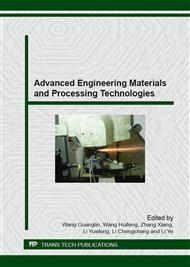p.292
p.298
p.303
p.308
p.314
p.320
p.326
p.335
p.341
Study on Characteristics of Green Parts of Birch Flour/Polyester Composite by Selective Laser Sintering
Abstract:
In this paper, the birch flour was the raw material with its particle size less than 100μm and the polyester hot-melt adhesive was used as binder with its particle size less than 60μm. The birch flour was dried using high speed mixer with heating function. The birch flour/polyester composite were prepared using the physical mixing method. The surface of the specimen and fracture surface of specimen were analyzed through the micrographs of scanning electron microscopy. In order to study the characteristics of laser sintering, the preheating temperature of the powder bed of laser sintering machine and the processing parameters of the birch flour/polyester composite were determined using single layer sintering method and empirical method. The tensile, flexural and impact specimens were built in the two scanning laser ways of subarea scan and progressive scan. The testing results show that the mechanical properties using subarea scan method are superior to those of progressive scan method and the mechanical properties of the specimens increase as the laser scan speed decreases. The best mechanical properties of SLS specimens of brich flour/polyester composite powder were obtained with the following parameters: the laser power was 11W, layer scan speed was 1800mm/s; layer thickness was 0.1mm; laser scan spacing was 0.1mm and the average tensile, flexural and impact strength of specimens were 1.35MPa, 3.69Mpa and 0.73KJ/m2 respectively.
Info:
Periodical:
Pages:
314-319
Citation:
Online since:
October 2015
Authors:
Keywords:
Price:
Сopyright:
© 2016 Trans Tech Publications Ltd. All Rights Reserved
Share:
Citation:


